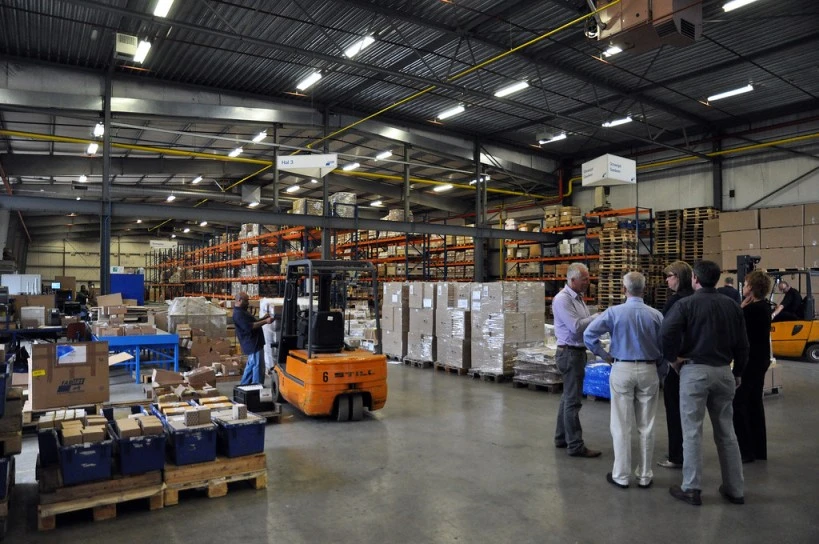We like to see warehouses as tidy, purposeful spaces where everything has a place and nothing is out of place. However, the truth is that the warehouse in a lot of businesses does not resemble the perfect image that we all imagine.
Maintaining order on a daily basis is often difficult. We frequently deal with misplaced items, piled-up pallets in inappropriate places, and machinery that needs to be put away at the end of the day. In order to enable activity, preserve productivity, and prevent accidents, an effort must be made to ensure that the workspace maintains vital order.
What factors need to be considered to create and maintain an effective organization? Let’s find out.
Read also: How to Manage a Warehouse: The 10-Step Guide to Logistics Management
7 Steps to Organize Your Warehouse
In a warehouse, disarray pays a price. Many easily preventable problems can result in lost time: neglected items, packaging that hasn’t been taken off, spills that trip staff, unnecessary trips because inventory is distributed randomly, and mistakes brought on by inadequate signage of the storage areas.
While we might go on enumerating these kinds of effectiveness “leaks,” we would rather offer you a few straightforward suggestions for maintaining warehouse organization and avoiding situations like these. You can take the following steps to further organize your warehouse:
1. Establish a cleaning routine
Maintaining a clean warehouse needs to be a top concern. The workers on each shift must understand that they have to schedule time each day to sweep, clear the work surfaces, remove any leftover packing, and otherwise leave their workspace tidy. In this manner, the next group will discover a setting that works for the advancement of His task.
Not only can cleanliness improve the working atmosphere. It also boosts security and gets rid of possible hazards. Scheduling a routine deep cleaning is also crucial.
2. Create protocols for workers
Employees need to understand how important it is to keep the warehouse organized. However, this need not be a vague notion that the employee is incapable of executing. Establishing protocols and teaching employees how to follow them are essential.
It is necessary to develop goals that will be evaluated on a regular basis with the intention of preserving and enhancing the organizational principles throughout time.
3. Floor markings
For everyday operations to continue in a safe and orderly manner, warehouse floor markings are essential. They designate the places where people or machinery can pass through and where they cannot, in addition to the direction in which they must move.
They are necessary to ensure that internal displacements make sense and that other people’s activities are not disturbed or interrupted.
Marking the aisles, shelves, rows, and various areas of the warehouse is also crucial.
4. Organize inventory
It is more practical to arrange inventory using the ABC approach based on rotation.
The commodities with the largest turnover should be identified and placed close to the shipping areas so that handling them can be done as quickly and easily as possible.
Workers’ tasks will be made simpler and there will be less travel if they are all in the same place. The most often requested items should be put at an appropriate height to make the picking process more effective, without the use of additional equipment such as forklifts, stepladders, and so on.
Order is maintained throughout the rest of the warehouse by developing an agile system to handle the most in-demand products.
5. Use a smart labeling system
It is inefficient to manually count inventory or warehouse assets. Barcode systems are also somewhat limited, even though they are an advancement. Using RFID tags can help you create the most straightforward and effective labeling system available.
Everything must be labeled in order to preserve workflow and warehouse structure. This helps prevent confusion and lost time when employees try to locate products that are frequently not where they should be.
6. Reserve space for reverse logistics
Many warehouses overlook handling returns and don’t designate a space for gathering and handling returned goods. Consequently, they wind up stacking in the wrong locations and causing an issue. Putting in place an appropriate reverse logistics plan prevents that from happening.
Read also: 6 Unheard Tips to Optimize Reverse Logistics in Your Business
7. Do periodic reviews
Since warehouses are living environments that are always changing, it’s critical to regularly assess the precautions that have been taken and adjust them as needed.
It is highly advised that you get staff feedback on this. Find out what obstacles they face in their day-to-day job and what tips they have for bettering the way their workspace is organized. They’ll provide you with solutions.
Lastly, we would like to remind you that if the management of the warehouse is not automated using software designed specifically for warehouses, like various WMS, then there is no way to further improve the organization of the warehouse.
Please don’t hesitate to contact us with any queries you may have about warehousing or logistics.



